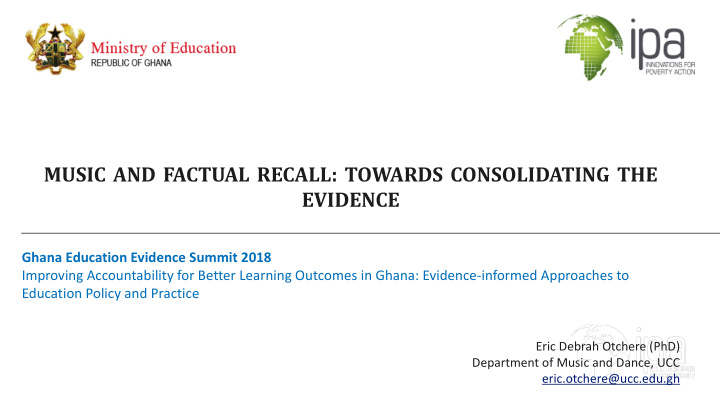



MUSIC AND FACTUAL RECALL: TOWARDS CONSOLIDATING THE EVIDENCE Ghana Education Evidence Summit 2018 Subtitle placeholder Improving Accountability for Better Learning Outcomes in Ghana: Evidence-informed Approaches to Education Policy and Practice Presenter Name Title of Presenter email@poverty-action.org Eric Debrah Otchere (PhD) Department of Music and Dance, UCC eric.otchere@ucc.edu.gh
OUTLINE OF PRESENTATION q BRIEF CONTEXT q PROCEDURE q FINDINGS/DISCUSSION q RECOMMENDATIONS q CONCLUSION
CONTEXT v Alfred Tomatis (“Why Mozart”- 1991): retrain ear, promote healing, develop brain. v Rauscher, Shaw and Ky (1993) - Sonata for Two Pianos in D major, K. 448 v Zell Miller v Mozart effect – Subsequent studies v Arousal and mood hypothesis v Does music make us smarter? (Indicators) W. A. Mozart 1756 - 1791
PURPOSE OF THE STUDY v to find out if there was any significant difference in the performance (ability to retain and recall taught facts) of two major groups of pupils in the same class who had been taught the same lesson, but using different procedures; one group with a musical intervention and the other group without any music at all.
LESSON – RIVERS OF GHANA
THREE MELODIES Original Order Ø Volta Ø Oti Ø Sene Ø Tano Ø Daka Ø Pra Ø Densu Ø Ankobra Ø Ayensu
THREE MELODIES
Two Phases Study Design: Quasi-Experimental Four weeks after lesson Eight (8) weeks after lesson EXPLORATORY PHASE VERIFICATION PHASE GROUP A 13 STREAM A 46 GROUP B 13 STREAM B 42 GROUP C 13 STREAM C 41 GROUP D 12 STREAM D 43 TOTAL 51 TOTAL 172 TOTAL SAMPLE = 223 BASIC 6 PUPILS FROM TWO SCHOOLS
A (GROUP/STREAM) – No Musical Intervention B (GROUP/STREAM) - Melody 1 C (GROUP/STREAM) - Melody 2 D (GROUP/STREAM) - Melody 3
In all, there was a significant mean difference between the musical groups and the non-musical group in both phases ANOVA Exploratory Phase Verification Phase F 3,47 = 13.41, p < .001 F 3,168 = 31.51, p < .001
Comparison of the means between groups/streams in both phases Mean score in the music intervention groups did not reach statistical significance.
OF SIGINIFICANCE … Ø Pupils in the Music Intervention groups mentioned the names of the rivers in the order in which they were arranged in their respective melodies. Ø There was no such order in the A groups in both phases
Key Points Ø Simple musical songs can transform ordinary text into information that is effectively retained and recalled when needed (Salcedo, 2010). Ø Music provides a natural and enjoyable medium for rehearsal and reinforces information in the brain. Ø Various elements of music mutually encode information in the brain and provides prompts for retrieval (see multi-sensorial learning theory) Ø Music stirs arousal, increases participation and aids in readiness for new information.
Reimer (2003) avows that “the impact the (Music Education) profession can make on society depends in large degree on the quality of the profession’s understanding of what it has to offer that might be of value to society” (p.2).
v Beyond being studied for it’s own intrinsic merit, music as a pedagogical tool must be further explored in Ghana. v Address the seeming disconnect between Colleges of Education and Basic Schools as far as music is concerned v Enhance coordination between tertiary and basic education ministries and sectors v Teacher trainees must be equipped to be able to compose simple melodies for core points of lessons
Consolidated idea The Ministry of Education should sponsor a working collaboration between Music Educators in Ghana and other subject groups so that musical materials will be developed for the teaching of all subjects, especially at the basic school level.
“…adding music is an excellent means for maximizing instructional time, deepening the conceptual complexity of the subject, and increasing students’ retention and recall; it is an excellent way to expand the pedagogical repertoire” (Kimball and O’Conner, 2010 p. 320).
Thank you Thank you
References Demorest, M. S. & Morrison, S.J (2000). Does music make you smarter? Music educators Journal. 87, 2, 33-39 + 58. MENC. http://www.jstor.org/stable/3399646 Accessed: 29/05/2009 17:45 Kimball, K., & O'Connor, L. (2010). Engaging auditory modalities through the use of music in information literacy instruction. Reference & User Services Quarterly, 49(4), 316-319. Retrieved February 27, 2011, from Research Library. (Document ID: 2054168531). Salcedo, C. S. (2010). The effects of songs in the foreign language classroom on text recall, delayed text recall and involuntary mental rehearsal. Journal of College Teaching & Learning , 7(6), 19-30. Retrieved from EBSCO host .
References Rauscher, F.H.,S haw,G .L., & Ky, K.N. (1995). Listening to Mozart enhances spatial-temporal reasoning: Towards a neurophysiological basis. Neuroscience Letters ,1 85, 44-47. Reimer, B. (2009). Seeking the significance of Music Education; Essays and Reflections. Rowman & Littlefield Publishers, Inc. U.S.A Schellenberg, E. G (2006). Exposure to music: the truth about the consequences. In G. E. McPherson (Ed.). The child as musician. A handbook of musical development . New York: Oxford University Press. Pg. 111-134 Schellenberg, E. G. (in press). Music and non-musical abilities. Annals of the New York Academy of Sciences.
Recommend
More recommend